Total posts:
187
07/09/2011
July 12th, 2011 by Ian Richardson
Elaborate hairstyles, choral singing and Middle English were all on the menu at the most recent themed late opening of the British Museum. The ‘Medieval Late’ evening on Friday, 8 July saw the grounds and central area of the museum, as well as many of the galleries, open until 9:00pm while a host of themed events occurred throughout. The current major exhibition ‘Treasures of Heaven: saints, relics and devotion in medieval Europe’ was the obvious source of inspiration for the evening, and the starting point for the plethora of informational activities and refreshments available to guests.
The regular closing time for the British Museum is 5:30pm, so for some guests it undoubtedly came as a pleasant surprise to find that they weren’t being ushered towards the door at that time, but rather encouraged to stay for the festivities to come. There was something for everyone on the agenda: gallery talks and lectures for the studious, art classes and chances to dress-up for the hands-on, theatre and singing for the observant and food and drink for the, uh, gluttonous.
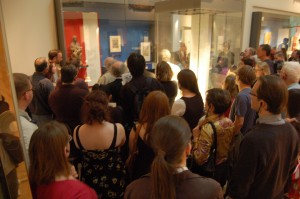
Flickr
After hearing her speak at the staff opening of ‘Treasures of Heaven’, I wanted to attend project curator Anna Harnden’s gallery talk. Swelled to capacity, the southeast corner of the Medieval gallery (Room 40) is the home of the subject of Anna’s talk, a woodcut of the Virgin and Child with Eight Virgin Saints. For someone who doesn’t know his Catherine from his Barbara, this was a lively and useful overview of the lives and legends of some of the most important virgin saints (and their attributes), which is crucial to appreciating reliquaries on display in the main exhibition. Her introduction to the cult of saints also helped to put into context many of the objects which are found by members of the public and recorded by the PAS, like this recent find of a possible badge of St Ursula from Lancashire (LANCUM-61F133).
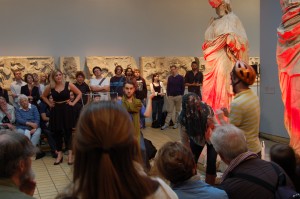 ](http://www.flickr.com/photos/finds/5928752685/in/photostream)
](http://www.flickr.com/photos/finds/5928752685/in/photostream)
As many will appreciate, the panoply of spaces in the British Museum make it adaptable to a variety of uses, and the organisers of the ‘Medieval Late’ took advantage of this. Colleagues spoke in admiration at the wonderful sounds and atmosphere of the Enlightenment Gallery (Room 1) generated by the Renaissance Singers, who kept to the theme by including medieval songs in their repertoire. The Mausoleum of Halikarnassos gallery (Room 2) with its two specially-lit colossal statues formed the stage for a young acting troupe’s twist on Chaucer’s Canterbury Tales, which[ was seen by an overflowing crowd of onlookers. Even a presentation on the art of medieval hairdressing for film and theatre was given a dramatic location in front of the Nereid Monument in Room 17.
The special period menu available in the Great Court was fairly adventurous and there were several guests who appeared to sample most of what was on offer: wild boar sausage, ox tongue, and pickled vegetables. I tried the hard-boiled duck egg with mustard sauce and spinach, which proved a heart, tasty treat for a reasonably-priced £1.50. I did feel that the caterers were ambitous in their attempt to sell bottles of ‘Mead’ – actually Fuller’s ‘Honey Dew’ Ale – for £5.00 each, but obviously the general public were happy to imbibe, as the beer sold out by 7:30pm.
 ](http://www.flickr.com/photos/finds/5928751035/in/photostream/)
](http://www.flickr.com/photos/finds/5928751035/in/photostream/)
I think the museum did well to put on a host of activities based on a central theme whilst at th[e same time allowing those who simply wanted to wander the galleries, visit the shops or enjoy the restaurants, the opportunity to do so at their own pace, without having the medieval world thrust upon them. Nonetheless the sheer size of the museum means that many events can be going on in disparate locations and it can be difficult for a visitor who does want to engage with the theme to decide what is worth attending. It would be great to see a specially constructed information ‘Hub’ on the forecourt or colonnade to grab the attention of guests as they enter the museum and direct them to the ongoing events and inform them of cancellations. That aside, the Medieval Late was an enjoyable, entertaining and worthwhile programme which greatly complimented the ongoing major exhibition. If they haven’t visited ‘Treasures of Heaven’ already, I’d bet this evening inspired a few more guests to check it out.
05/25/2011
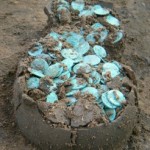
Latest news from Philip Crummy at the Colchester Archaeological Trust
In the days before banks, people would bury their money in pots for safe keeping rather than leave them lying about the house under the bed or in a cupboard. The money would be safe but things could still go wrong. Occasionally, the owners couldn’t find it again – imagine the panic! – or sometimes they died without telling anybody where they had hidden their cash.
Something like this must have happened on the site of the Hyderabad and Meeanee barracks on Mersea Road Colchester where last March we found a hidden stash of 1,247 Roman coins. They lay inside a small grey-ware pot which had been buried in the ground at a slight angle.
The coins are of a type known as antoniniani. The hoard is made up of issues of at least nine Roman emperors ranging from Gallus (251-3) to Victorinus (269-271). The latest coins in the hoard point to a date for its deposition in the early part of AD 271.
The antoninianus started life off as a silver coin issued in the early 3rd century but, by the time of the Hyderabad hoard, it had become very debased and ended up as a copper-alloy coin with a very thin silver coating. Severe inflation reduced its monetary value which is why later antoniniani are common finds on archaeological sites of the third quarter of the 3rd century. The Hyderabad hoard belongs to this period.
The burial of coins seems to have been more common in periods of unrest or uncertainty. The 270’s was a difficult time in eastern England because of civil war in the Roman Empire and serious raiding along the coast by foreign peoples. This explains why the Hyderabad hoard is not the first hoard of this period to have been discovered in the Colchester area. Over a hundred years ago, one, possibly two, hoards of the date were found in Colchester itself although the precise find spot is not known. Also over 6,000 antoniniani were found in three pottery vessels at Gosbecks in 1983, the latest coins dating to between AD 270 and 274. And some distance from Colchester, a hoard of about 657 antoniniani was discovered at East Mersea in about 1980. This fits the pattern with its latest coins being again in the range of 270 to 274.
When discovered, the Hyderabad hoard was carefully removed intact from the site and excavated indoors so that the positions of all the coins could be studied and recorded as the pot was emptied. The distribution of the coins in the pot in relation to their dates suggest that the coins had all been placed in there at the same time. In other words, no clear evidence was found to suggest that the pot had been used like a piggy bank with coins being added as time passed by. Instead all the coins appear to have been put in the pot at the same time and then buried. Interestingly many of the coins inside the pot looked as they had been placed in there in little stacks. From this, we can visualise the owner sorting out his money into neat piles on a table so that he could count it accurately before putting the coins in the pot stack by stack.
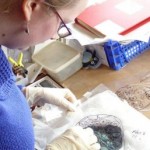
Samuel Pepys famously recorded in his diary what could go wrong if you had to resort to digging holes to protect your savings. The Dutch fleet was about to sail up the Thames and consequently Pepys, living in London, was worried about his money. So he decides to ask his wife to take £1300 in gold secretly to his father-in-law’s house in Brampton in Huntingdon and bury it there. But, horror of horrors, his father hadn’t a clue how to carry out this relatively easy task. The man simply buried the money in the middle of his front garden and, worse, did it in broad daylight for all to see. A few months later, an anxious Pepys was in the garden himself. He waited until it was dark, lit a candle, and then got to work. He found the buried treasure sure enough but – oh no! – the bag had rotted and, despite some frantic sieving, about 25 coins couldn’t be found.
The Hyderabad hoard had not been buried in somebody’s garden. Instead it looks as if it had been buried in the side of a field well away from prying eyes. The place were it had been hidden turns out to have been an interesting one because it was part of one of the defensive earthworks which protected pre-Roman Colchester (Camulodunum). This system of earthworks, known as dykes, originated up to a hundred years before the Roman invasion of Britain and the subsequent foundation of Roman Colchester. The Hyderabad hoard had been buried in the upper part of the filling of the ditch of the Berechurch Dyke which, until the recent excavations, had not been traced this far north. The dyke system at Colchester included at least 15 miles of earthworks and represents the largest complex of its type and date in Britain. This latest discovery adds about another half a mile to known extent of the complex.
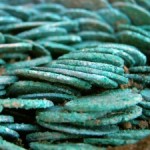
The discovery of hoard has been reported to the Portable Antiquities Scheme and Treasure Department at the British Museum. The landowner, Taylor Wimpey, will then donate the hoard to the Colchester Museum and the people of Colchester just as they are doing with all the other finds from their sites on former Colchester Garrison land.
The excavations at the Hyderabad and Meeanee site were carried out by the Colchester Archaeological Trust on behalf of Taylor Wimpey who have funded all the work. RPS act as archaeological consultants to Taylor Wimpey and manage the project on the company’s behalf.
04/28/2011
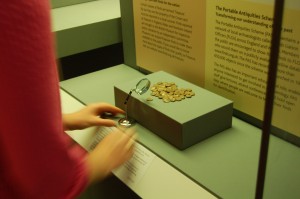
Currently on display in the Portable Antiquities & Treasure case in Gallery 41 of the British Museum is a selection of coins belonging to a hoard which represents the largest collection of Iron Age gold coins found since the mid-19th century. The selection of 50 coins accounts for only a small fraction (6%) of the entire hoard, which has 840 coins in total.
The Wickham Market (Suffolk) hoard was found in the Spring of 2008 by two metal detectorists, who also found the base and body parts of a wheel thrown ceramic jar. After identification and cataloguing by the Iron Age curator, Ian Leins, it was concluded that the majority of the coins were struck between 40BC- 15BC. This is a period of time linked with perhaps one of the best known tribes of Celtic Britain, the Iceni. The Iceni tribe occupied the area of Norfolk and Suffolk and were immortalised after being led by Boudica in a large scale revolt against the Roman legions.
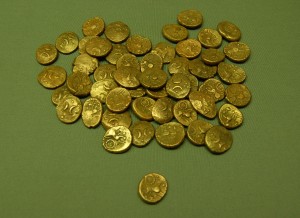
Following the reporting of the hoard archaeologists from the Suffolk County Council Archaeological service were given the opportunity to excavate the site. This allowed them the chance to assess the area of deposition and investigate for other possible features. Topsoil excavation revealed that the coins were scattered a short distance from the original burial spot. An additional 52 coins were uncovered and the archaeologists were able to make several conclusions: that the location of the hoard conforms to other sites in Norfolk, where gold items have been found buried on high ground; that the site has a continuing phase of activity up to the end of the Roman period; and although tribal affinities in the area remain complex, it is believed that the coins, due to their contemporary value, may have been deposited as part of a ritual practice . In terms of qualifying as Treasure under the Treasure Act 1996 the find is clearly a single find, confirmed by the discovery of pot sherds of a contemporary date.
The Treasure Valuation Committee has recommended a valuation of £300,000 approved by the Secretary of State and agreed by all interested parties. From May 2011 Colchester and Ipswich Museum Service will also be displaying a selection of coins to begin its monumental task of raising the funds towards the acquisition of this find. The fundraising campaign will be a testament to an incredibly important discovery for this area of the country.
04/21/2011
With Royal wedding fever all over media I was interested to come across this find which shows souvenirs of Royal weddings are nothing new. It is a silver heart shaped locket found in two pieces with moulded portraits of a crowned Charles II on one side (flanked by the incised initials C/R) and his wife, Katherine of Braganza, (flanked by K/R) on the other. It commemorates their marriage in 1662 and was found near the site of the Battle of Sedgemoor, which took place on 6th July 1685. It is possible that the locket was lost by someone fighting on the side of the King during the battle.

SOM-C6EDD1: Locket commemorating the marriage of Charles II and Katherine of Braganza
Having been through the Treasure process (2004 T247), the locket was acquired by Somerset County Museum (accession number TTNCM 202/2005) and will be on display in the Museum of Somerset when it opens in the summer. Half of a similar locket was featured in the September 2004 issue of Treasure Hunting magazine (p. 17) suggesting it was a souvenir produced in some numbers rather than an individual commemorative item.
A more commonly found item which is also thought to commemorate this wedding is a type of cufflink, found in both silver (LVPL-BF30A6 and PAS-625C72) and cheaper lead alloy copies (LON-306542 and ESS-B32D14). They show either two crowned hearts or clasped hands with a crown above and two flaming hearts below. Although items with this design are thought to have originally been made to commemorate the marriage of Charles II and Katherine of Braganza the design continued in use probably into the 18th century as a general symbol of love and/or marriage.
Other Royal wedding souvenirs recorded by the PAS include a copper alloy medalet from the wedding of the Prince Regent (the future George IV) and Caroline of Brunswick in 1795: HAMP-0F4355and this Roman Denarius (DUR-3D7720) of Plautilla wife of the Emperor Caracalla minted in Rome 202 AD to celebrate their wedding. For other wedding related finds see this search on our database.
03/18/2011
The Talbot Vervel
I have been sent details of this press release from Shropshire Council Museum service about their recent acquisition through the Treasure Act of a silver vervel belonging to the 10th Earl of Shrewsbury – John Talbot. Not only does this release highlight the work of the PAS, and museum but it praises the finder, Frank Taylor, who has a long standing working relationship with the Museum Service which predates the PAS.

Vervel of John Talbot - Earl of Shrewsbury
The release reads:
Shropshire Council’s museum service has acquired another remarkable find by local metal detectorist, Frank Taylor – a small hoop and shield that gives us a glimpse into the life of the Earl of Shrewsbury around 380 years ago.
It was acquired due to the generosity of the V&A/MLA Purchase Grant Fund and Headley Trust.
Although small, this hoop and shield are inscribed with the name IOHN TALBOT (John Talbot) and the emblazoned with a hound or ‘talbot passant’ which was the family crest of the Earls of Shrewsbury. The design and style of the lettering suggests that the owner was probably Sir John Talbot, 10th Earl of Shrewsbury (1601-54).
Sir John Talbot inherited the title, Earl of Shrewsbury, in 1630, a title somewhat disgraced by the family’s connections with Catholicism and involvement with the Gunpowder Plot. The family owned a significant estate at Pepperhill, Albrighton, not far from the field where Frank made his discovery.
Steve Charmley, Shropshire Council’s Cabinet member for culture and leisure, said:
“Frank Taylor has been very supportive of the museum service for over thirty years and has, with the agreement of the landowners, donated many of his finds. Working with responsible metal detectorists like Frank helps us to research and display fascinating insights into Shropshire’s past. It is crucial to our work.”
Frank took his find to be recorded and identified by Peter Reavill, Finds Liasion Officer for Herefordshire and Shropshire as a vervel. Vervels are small inscribed tags which were worn on a hawk’s leg to attach leather jesses. These tags are often inscribed with the owners name, residence or coat of arms [often the coat of arms was placed on the vervel as not all the locals would have been able to read].
Emma-Kate Lanyon, Curator with Shropshire Council’s museums service, said:
“In broad terms a vervel fulfils the same function as modern racing pigeon rings. If a valuable bird was lost whilst hunting it could be identified and returned to the owner. Falconry was a sport for nobility and rings similar to this at the British Museum belonged to King Charles II. The discovery of this example in a field in the adjacent parish to the home of the Earl of Shrewsbury fits well with a loss whilst out enjoying the hunt and gives us a glimpse into the life of a family which has been at the heart of political affairs in the county from medieval times.”
Janet Davies, Head of Regional Liaison & Purchase Grant Fund said:
“We were pleased to help the museum acquire this interesting piece. It’s a good example of how modest items are significant in shedding light on life in the past.”
At the moment museum staff are working to develop the seventeenth century displays for the new Shrewsbury Museum and Art Gallery which is due to open in 2012. Hopefully, the verval will be displayed here as part of the story of Shropshire during this period.
For the full PAS Treasure report and for details of the original press release.
03/17/2011
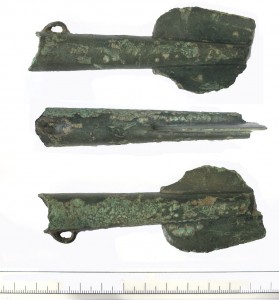
In January this year a local metal detectorist kindly donated one of his finds to my handling collection to be used on outreach and education events. As it got to the front of my queue of artefacts this week, my volunteer and I set to pinning it down typologically in order to record it.
Initial searches could not find a similar example and so we turned to Dot Boughton, one of the NW FLO’s who has a lot of experience with Bronze Age material. She agreed that the addition of a single side loop was unusual and referred us onto Richard Davis, a Bronze Age spear expert. He very kindly got back to us rapidly with the following information ‘ ’Spearheads with a single loop down the socket are rare. There are only six like this from Britain, none from Ireland. They have a very tight distribution
pattern:-
Medomsley, Durham
Netherby Fort, Cumbria (2)
Snape, North Yorks
Dumfries
Glenkens, Dumfries
They can be attributed to the Penard phase of the MBA, which is now dated 1250-1125BC.
This identification was great, and the location of our spear, in County Durham, fits within the known distribution pattern which is great. It is now recorded on the PAS database as DUR-F54FE1 and only narrowly missed being put in Richard’s new book but it was shown to him too late. It is always nice to get local finds, and to know that it will be available for further study in the future, as well as helping other members of the public get closer to the past.

 ](http://www.flickr.com/photos/finds/5928752685/in/photostream)
](http://www.flickr.com/photos/finds/5928752685/in/photostream) ](http://www.flickr.com/photos/finds/5928751035/in/photostream/)
](http://www.flickr.com/photos/finds/5928751035/in/photostream/)






